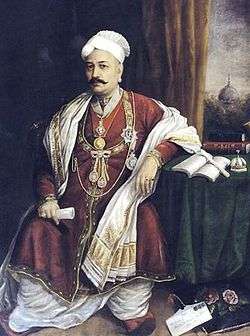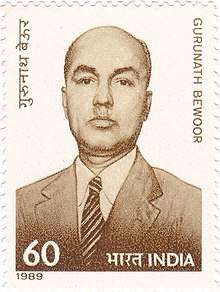List of Deshastha Brahmins
Deshastha Brahmins form a major sub-caste of Brahmins in the states of Maharashtra and parts of Karnataka in India. The following is the list of notables from Deshastha Brahmin community.
Religious figures
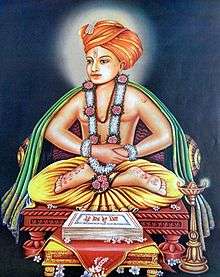
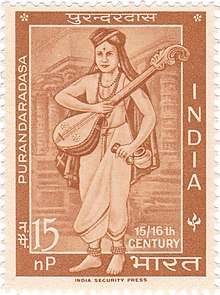
Purandara Dasa on Indian postal stamp.
- Nivruttinath (1273–1297) - older brother of Dynaneshwar; Varkari saint and philosopher[1]
- Dnyaneshwar (1275–1296) - 13th-century Marathi Varkari saint, poet, philosopher and yogi of the Nath Vaishnava tradition[1]
- Sopan (1277-1296) - saint of the Varkari sect; younger brother of saint Dnyaneshwar[1]
- Muktabai (1279-1297) - younger sister of Saint Dynaneshwar; Varkari saint and philosopher[1]
- Chakradhar Swami - 13th century Vaishnava saint; founder of the Mahanubhava sect.[2]
- Jayatirtha (1345 – 1388) - a Hindu Dvaita philosopher, dialectician, polemicist and the 6th pontiff of Madhvacharya Peetha.[3]
- Sripadaraja (1422 - 1480) - a Dvaita scholar, composer and the pontiff of the Madhvacharya mutt at Mulbagal, who is widely considered as the founder of Haridasa movement along with Narahari Tirtha.[4]
- Vyasatirtha (1460 – 1539) - a Dvaita philosopher, scholar, yogi and poet; Rajaguru of Krishnadevaraya of Vijayanagara Empire.[5]
- Bhanudas (1448–1513) - a Hindu Varkari saint and devotee of Vithobha.[6]
- Purandara Dasa (1484 - 1564) - a Haridasa, Dvaita philosopher and saint; Pitamaha of Carnatic Music.[7]
- Janardan Swami (1504 -1575) - an Indian scholar, statesman, a prominent Marathi sant, religious poet of the Varkari sampradaya, a devotee of Dattatreya and the guru of Eknath.[8]
- Vijayendra Tirtha (1514 - 1595) - a Dvaita philosopher, dialectician and prolific writer, who authored 104 works on Dvaita Vedanta.[9]
- Raghuttama Tirtha (1548 - 1595) - a Dvaita philosopher, scholar, saint and mystic; 14th pontiff of Uttaradi Math[10]
- Eknath (1533–1599) - Marathi saint, scholar, and religious poet of the Varkari Sampradaya[11]
- Dasopant (1551–1615) - Marathi poet-saint and prolific writer of Varkari sect.; also known as Daso Digambar[12]
- Raghavendra Tirtha (1595 - 1671) - a Dvaita saint, scholar, mystic and theologian; pontiff of mutt at Kumbakonam.[3]
- Vaman Pandit (1608–1695) - a Marathi poet and scholar, who composed poems and kirthanas on Lord Krishna and gave a sound metaphysical foundation to the concept of Bhakti in Maharashtra.[13]
- Samarth Ramdas (1608–1681) - Hindu Vaishnava saint from Maharashtra[14][15]
- Shridhar Swami Nazarekar (1658–1729) - author of works of devotional literature in marathi: Harivijaya, RamVijaya, Shivlilamrut, PandavaPratap, and the AmbikaUdaya; his real name was Khadake Nazarekar[16]
- Vijaya Dasa (1682–1755) - a prominent Hindu saint from the Haridasa tradition of Karnataka, India.[17]
- Mahipati (1715–1790) - author of Bhaktavijaya, a Marathi language biography of Varkari and other Hindu saints[18]
- Satyadharma Tirtha (1743-1830) - a Dvaita philosopher, scholar, saint and mystic ; 28th pontiff of Uttaradi Math [19]
- Manik Prabhu (1817 -1865) - An early 19th-century Hindu Vaishnava saint, philosopher, poet and mystic.[20]
- Bhausaheb Maharaj (1843 - 1914) - a Hindu saint, philosopher and founder of Inchegeri Sampradaya.[21]
Historical figures
Medieval India
- Hemadri Pandit - prime minister from 1259 to 1274 C.E. in the regimes of Kings Mahādeva (1259–1271) and Ramachandra (1271–1309) of Seuna Yādava Dynasty of Devagiri, which ruled in the western and southern part of India.[22][23]
- Vyasatirtha (1460 – 1539) - Rajaguru to Kings Saluva Narasimha Deva Raya and Krishnadevaraya of Vijayanagara Empire.[5]
Maratha Empire
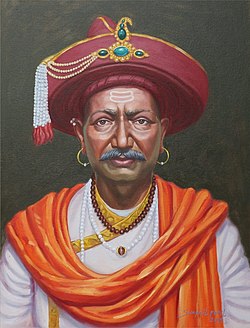
Painting of Ramchandra Pant Amatya
Peshwas
- Moropant Trimbak Pingle (1657–1683) - the first Peshwa in Shivaji Maharaj's Asthapradhan mandal[24]
- Nilakanth Moreshvar Pingale (1683-1689) - the second Peshwa of the Maratha Empire and elder son of Moropant Trimbak Pingle.
- Ramchandra Pant Amatya (1689-1708) - Amatya, Peshwa and Hukumat Panah of the Maratha Empire during the reign of Shivaji and Rajaram I.[25]
- Bahiroji Pingale (1708–1711) - the fourth Peshwa of the Maratha Empire and the younger son of Moropant Trimbak Pingle.
- Parshuram Trimbak Kulkarni (1711–1713) - the fifth Peshwa of the Maratha Empire and also the founder of Aundh and Vishalgad Samsthanams.
Sachivs
- Annaji Datto Sacheev - was the Sachiv in the Ashta Pradhan mandal of Maratha Empire during the rule of Chhatrapathi Shivaji.[26][27]
- Shankaraji Narayan Gandekar and his descendants were hereditary Sachiv's of Maratha Empire and the rulers of Bhor.[28]
Pratinidhis
- Pralhad Niraji - was the Pratinidhi of the Maratha Empire during the reign of Chatrapathi Rajaram I. He was the first occupant of the position of Pratinidhi.[29]
- Parshuram Pant Pratinidhi and his descendants were the hereditary Pratinidhi's of the Maratha Empire and also the rulers of Aundh and Vishalgad.[30]
Other notable Maratha Empire people
- Dadoji Konddeo - administrator of Shahaji's fiefdom and mentor to Shivaji.[31]
- The Vinchurkars - generals and nobles at the Peshwa court[32]
- The Purandares - generals and nobles at the Peshwa court[33]
- The Chandrachuds - generals and nobles at the Peshwa court[34]
- Antaji Mankeshwar Gandhe - Maratha general and Governor of Delhi/Faridabad from 1729-1761[35]
- Ramshastri Prabhune, was the Chief Justice (Mukhya Nyayadhish or "Pantnyayadhish") in the apex court of the Maratha Empire in the latter half of the 18th century, during the heyday of that empire. He is best remembered for having passed strictures against the sitting Peshwa of the time for instigating murder.[36] Ram Shastri's integrity in public affairs is regarded as a model for all times.[37]
- Sakharam Bapu Bokil - regent to Madhavrao II.[38]
- Niranjan Madhav Parasnis - diplomat, who also worked as Parasnis under Peshwa Bajirao I. [39]
- Anandarayar Sahib, Diwan of the Thanjavur Maratha kingdom during the reigns of Shahuji I, Serfoji I and Tukkoji.
Rulers during British colonial era
- Pant Pratinidhi Rajas of Aundh State and Vishalgad estate.
- Gandekar Rajas of Bhor State
- Rao Saheb Rajas of Arni estate.[40]
- Vinchurkar rulers of Vinchur estate
- Bawadekar rulers of Bavda estate
Diwans, Bureaucrats and Diplomats during British colonial era
During the rule of British Raj the most powerful Brahmin bureaucrats in the South India were Deshastha Brahmins, who had migrated from Maharashtra to South India.[41] In 19th century, out of 305 high level administrative officials 174 were from Deshastha Brahmin community, while 83 were drawn from other Brahmin groups in South India.[42]
- T. Madhava Rao (1829–1891) - Diwan of Travancore, 1857–1872; Diwan of Indore, 1873–1875; Diwan of Baroda, 1875 – 1882.[43]
- T. Ananda Rao (1852 – 1919)- 18th Diwan of Mysore
- T. Rama Rao (1831 – 1895) - Diwan of Travancore from 1887–1892
- R. Raghunatha Rao (1831 – 1912)- Dewan Bahadur of the princely state of Indore during British Raj from 1875–1888.
- T. Venkata Rao - Diwan of Travancore from 1821–1829.
- T. Subba Rao - Diwan of Travancore for two times from 1830–1837 & 1839 – 1842.
- V. P. Madhava Rao (1850 - 1934)- 17th Diwan of Mysore[44][45]
- N. Madhava Rao (1887 - 1972) - 23rd Diwan of Mysore
- Venkata Rayar - Diwan of Cochin kingdom from 1856 to 1860.
- K. Krishnaswamy Rao (1845 – 1923) - Diwan of Travancore from 1898–1904.[46]
- T. Ramachandra Rao (1825-1879) - Indian civil servant and first native Indian to serve as Deputy Commissioner of Police of Madras.
- R. Ramachandra Rao (1871 – 1936) - Indian civil servant and mathematician.
- Gurunath Venkatesh Bewoor (1888 – 1950) - Indian civil servant, the Viceroy's Executive Council during the World War II. His son Gopal Gurunath Bewoor was 9th Chief of Army Staff.
Indian Independence Movement

Statue of Tatya Tope
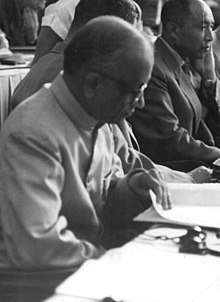
Shripad Amrit Dange, a founding member of the Communist Party of India (CPI).
Leaders of 1857 War of Independence
- Tantya Tope (Ramachandra Panduranga Yewalkar) (1814 - 1859) - one of the main military leaders of the Indian Rebellion of 1857[47]
Revolutionaries
- Shivaram Hari Rajguru (1908–1931) - Indian revolutionary and associate of Bhagat Singh[48]
- Vishnu Ganesh Pingle (1888-1915) - Indian revolutionary and member of the Ghadar Party who was one of those executed in 1915 following the Lahore conspiracy trial for his role in the Ghadar conspiracy.[49]
- Pandurang Sadashiv Khankhoje (1884 – 1967) - Indian revolutionary, scholar, agricultural scientist and historian who was among the founding fathers of the Ghadar Party.[50]
Others
- Balakrishna Shivram Moonje (1872–1948) - freedom fighter and early Hindu Nationalist leader[51]
- Madhu Dandavate (1924 - 2005) - an Indian freedom fighter who participated in Quit India Movement and many other movements during Indian national movement. He was politician and worked as Union minister of Finance and Railways.[52]
- Ganesh Shrikrishna Khaparde (1854 –1938) - an Indian lawyer, scholar, political activist and a founding member of Tilak's Indian Home Rule League.[53]
- Shripad Amrit Dange (1899 – 1991) - a founding member of the Communist Party of India (CPI) and a stalwart of Indian trade union movement.[54]
- Balkrishna Ganesh Khaparde (1882–1968) - Son of Ganesh Shrikrishna Khaparde, an Indian lawyer, a prominent leader in Swaraj Party and belonged to ‘Tilak School of Thought’.[55]
- Madhav Shrihari Aney (1880 - 1968) (Loknayak Bapuji Aney) - educationist, freedom fighter, statesman, 2nd Governor of Bihar; follower of Lokmanya Tilak and Winner of Padma Vibhushan Award.[56]
- Gangadharrao Balkrishna Deshpande (1871-1960) (also known as Lion of Karnataka) - an Indian activist who was the leader of the Indian independence movement against British colonial rule from Belgaum.[57]
- R. Balaji Rao (1842–1896), Indian politician and Indian independence activist. First Secretary of the Madras Mahajana Sabha. Represented Tanjore along with S. A. Swaminatha Iyer at the first session of the Indian National Congress.[58]
- Vasukaka Joshi (Vasudev Ganesh Joshi) (1856 - 1944) - freedom fighter and sole owner of Chitrashala press of Pune.[59]
Reformers & Social activists
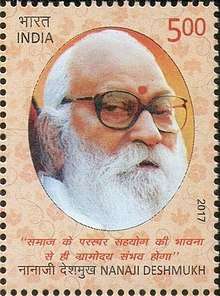
Bharat Ratna Nanaji Deshmukh on 2017 commemorative stamp of India.
- Nanaji Deshmukh (1916 – 2010) - social reformer, founder of Bharatiya Jana Sangh Party, MP of BJP; Bharat Ratna[60]
- N. Subba Rao Pantulu (1856 - 1941) - an Indian social activist and politician who served as a member of the Madras Legislative Council between 1893 and 1909 and also one of the founders of The Hindu.[61]
Bureaucrats & Diplomats
- Apasaheb Pant (1912 - 1992) - Indian prince, son of Raja Bhawanrao Shriniwasrao Pant Pratinidhi, Gandhian, writer, freedom fighter and diplomat; Ambassador to Indonesia (1961–64), Norway (1964–66), Egypt (1966–69),[62] United Kingdom (1969–72) and Italy (1972–75); Winner of Padma Shri.[54]
- Dattatraya Shridhar Joshi (born 11 October 1908) - 9th Cabinet Secretary of India from (27 June 1966 to 31 December 1968); Winner of Padma Vibhushan.[63]
- C. R. Krishnaswamy Rao Sahib (1927 – 2013) - 15th Cabinet Secretary of India from (30 April 1981 – 8 February 1985);Winner of Padma Vibhushan.[64]
Jurists and lawyers
- Pralhad Balacharya Gajendragadkar (1901 - 1981) - was the 7th Chief Justice of India, serving from 1 February 1964 – 15 March 1966; Winner of Padma Vibhushan.[65]
- Yeshwant Vishnu Chandrachud (1920 – 2008) - was the 16th Chief Justice of India, serving from 22 February 1978 to 11 July 1985.[54]
- Chandrashekhar Shankar Dharmadhikari (1927 - 2019) - former acting Chief Justice of Bombay High Court, son of freedom fighter Dada Dharmadhikari; Winner of Padma Bhushan.[66]
- Dhananjaya Yeshwant Chandrachud, son of Y. V. Chandrachud and is currently a sitting judge of the Supreme Court of India.[67]
Politics
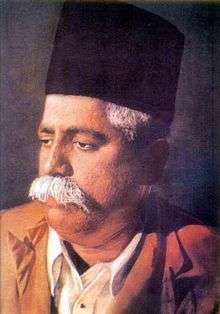
Portrait of K. B. Hedgewar, founder of RSS.
- Pramod Mahajan (1949–2006) - BJP politician, former Minister of Communications, Information Technology and Parliamentary Affairs . He was murdered by his brother[68]
- Ram Naik, BJP,[69] currently the 24th Governor of Uttar Pradesh[70]
- Hari Vinayak Pataskar (1892 - 1970) - an Indian lawyer and politician who was a member of the Constituent Assembly of India and 2nd Governor of Madhya Pradesh and Winner of Padma Vibhushan Award.[71]
- Narayan Malhar Joshi (1879 – 1955), Trade Union leader, founded the Social Services League, also founder of All India Trade Union Congress along with Lala Lajpat Rai.[72]
- Keshav Baliram Hedgewar (1889–1940) - founder of Rashtriya Swayamsevak Sangh (RSS).[73]
- Madhukar Dattatraya Deoras (1915 - 1996) - the fourth Sarsanghchalak of the Rashtriya Swayamsevak Sangh (RSS).[74]
- Dattatraya Sadashiv Parchure (1902–1985), a doctor and a member of the Akhil Bharatiya Hindu Mahasabha.[75]
Arts
Cinema and theatre
Actors
- Gajanan Jagirdar (1907–1988) - veteran Indian film director, screenwriter and actor. He worked in Hindi Cinema, also called Bollywood, as well as Marathi cinema.[76]
Literature
- Bhavabhuti – was an 8th-century Sanskrit scholar of India noted for his plays and poetry.[77]
- Pralhad Keshav Atre, (1898 – 1969) (popularly known as "Acharya Atre") - Marathi writer, poet, educationist, a movie producer–director–script writer and orator; Winner of President's Gold Medal[78]
- Kusumagraj (Vishnu Vaman Shirwadkar) (1912 – 1999) - a Marathi poet, playwright, novelist, short story writer; Jnanpith and Padma Bhushan awardee[78]
- Navaratna Rama Rao (1877 – 1960) - an Indian writer and scholar from Karnataka.[79]
- Vaman Malhar Joshi (1882 – 1943)- a Marathi writer.[80]
- Lakshman Shastri Joshi (1901–1994) - scholar of Sanskrit, Hindu Dharma, and a Marathi literary critic, and supporter of Indian independence. Awardee of Padma Vibhushan and Padma Bhushan awards[78]
- Rajeshwar Shastri Dravid (1899 - 1950) - Indian writer, scholar, grammarian and translator of Sanskrit literature; Winner of Padma Bhushan.[81]
- Siddheshwar Shastri Chitrav (1894 - 1984) - Indian Vedic scholar, lexicographer, translator and writer of Marathi literature; Winner of Padma Shri.[82]
- Bal Sitaram Mardhekar (1909 – 1956) - a prominent Marathi writer and winner of Sahitya Akademi Award[78]
- Ganesh Trimbak Deshpande (1910 - 1989) - an Indian writer, scholar and winner of Sahitya Akademi Award[78]
- Shrikrushna Keshav Kshirsagar (1901–1980) - Marathi writer from Maharashtra, India.[83]
- Gajanan Digambar Madgulkar (popularly known as "Ga Di Mā") (1919 - 1977) - Marathi poet, lyricist, writer and actor. Awardee of Padma Shri.[78]
- Vyankatesh Digambar Madgulkar (1927 - 2001) - younger brother of Gajanan Digambar Madgulkar, one of the most popular Marathi writers of his time and winner of the Sahitya Akademi Award [84]
- Vinayaka Krishna Gokak (1909 – 1992) - a writer in the Kannada language and a scholar of English and Kannada literature. Winner of Jnanpith Award[78]
- Ram Shri Mugali (1906 – 1993) - a writer in the Kannada language and winner of the Sahitya Akademi Award[78]
- Navaratna Srinivasa Rajaram (1943 – 2019) - an Indian writer, hindutva-scholar and historian.[85]
Historians
- Anant Sadashiv Altekar (1898–1960) - historian, archaeologist, and numismatist from Maharashtra, India[86][87]
- Datto Vaman Potdar (Dattatray Vaman Potdar) (1890 - 1979) - Indian historian, writer, orator; Vice-Chancellor of University of Pune during (1961 - 1964); Winner of Padma Bhushan.[88]
- Conjeevaram Hayavadana Rao (1865 – 1946) - an Indian historian, museologist, anthropologist, economist and polyglot. He was a member of the Royal Anthropological Institute, Indian Historical Records Commission and a fellow of the Royal Society of Economics.[89][90]
- Dattatray Balwant Parasnis (1870 – 1926) - a historian who lived during the British Raj. Conferred the title of Rao Bahadur by the British.[91][92]
- Sethu Madhav Rao Pagadi (1910 - 1994) - an accomplished historian, an able civil servant, a polyglot and Winner of Padma Bhushan.[54]
Music
Hindustani classical music
- Bal Gandharva (Narayan Shripad Rajhans) (1888 - 1968) - one of the greatest Marathi singers and stage actors.Winner of Sangeet Natak Akademi Award, the highest musical honour in India and the Padma Bhushan award, the third highest civilian award in the Republic of India.[93][94]
- Krishnarao Phulambrikar (1898 – 1974) (popularly known as Master Krishnarao) - an Indian vocalist, classical musician and composer of Hindustani music.Winner of Padma Bhushan award.[95]
- Sawai Gandharva (Ramachandra Kundgolkar Saunshi) (1886 - 1952) - a popular Hindustani Classical vocalist and Marathi stage actor of the Kirana Gharana. He was the first and foremost disciple of Ustad Abdul Karim Khan and guru of Bharat Ratna laureate Pandit Bhimsen Joshi.[96]
- Vasantrao Deshpande (1920 – 1983) - a Hindustani classical vocalist renowned for his contribution to natya sangeet (musical dramas), particularly his role as "Khansaheb" in Katyar Kaljat Ghusli; Winner of Sangeet Natak Akademi Award.[76]
- Narayanrao Vyas (1902–1984) - a Hindustani musician of Gwalior gharana.[76]
- Vamanrao Deshpande (1907–1990) - an Indian music critic, musicologist and a prolific writer on the subject of Hindustani classical music.[76]
- Gururao Deshpande (1889–1982) - a Hindustani classical vocalist from Karnataka.[76]
Carnatic classical music
- Purandara Dasa - a Haridasa, who is widely referred to as the Pitamaha (lit, "father" or the "grandfather") of Carnatic Music.[7]
- Mysore Sadashiva Rao (1800 – 1885) - a notable Indian vocalist and composer of Carnatic music in the traditions of Tyagaraja. He was a member of the court of the king of Mysore, Krishnaraja Wodeyar III.[97]
- Sakha Rama Rao - an Indian musician credited with having re-introduced the south Indian chitravina (or "gotuvadyam") to the concert scene.[98]
Military
- Gopal Gurunath Bewoor (11 August 1916 – 24 October 1989) - an officer of the Indian Army who served as the 9th Chief of Army Staff. Winner of Padma Bhushan and Param Vishisht Seva Medal[99]
Science and Technology
- Bhalchandra Nilkanth Purandare (1911 - 1990) - Indian Gynecologist; Winner of Padma Bhushan.[78]
- Suhas Pandurang Sukhatme - Indian scientist, son of Pandurang Vasudeo Sukhatme, former Chairman of the Atomic Energy Regulatory Board; Winner of Padma Shri.[78]
Mathematics and Statistics
- Bhāskarāchārya (1114–1185) - Indian mathematician and astronomer.[100]
- Pandurang Vasudeo Sukhatme (1911–1997) - Indian statistician; Winner of Padma Bhushan.[78]
Education
- Trimbak Krishna Tope (1914 - 1994) - former Vice Chancellor of University of Mumbai from (1971 - 1977).[78]
- C. D. Deshpande (1912 - 1999) - noted educationist, geographer, author, and teacher.[78]
- T. Gopala Rao (1832 – 1886) - educationist, served as the Principal of Government Arts College, Kumbakonam after William Archer Porter and first inspector of schools under British government.[101]
Business and Industries
- Malhar Sadashiv Parkhe (1912 – 1997) - an Indian industrialist and founder of Parkhe Group.[78]
- Vasantrao Madhavrao Ghatge (1916 – 1986) - an Indian entrepreneur, business magnate, industrialist and a professor and was the co-founder of Ghatge Patil Transports pvt. Ltd along in the year 1945 based in Kolhapur.[78]
- Bhalchandra Digamber Garware, (fondly referred to as "Abasaheb Garware") (1903 - 1990) - a pioneering industrialist and Founder Chairman of the Garware Group of Industries; Winner of Padma Bhushan.[78]
gollark: There is probably a lot of intermediate time where you don't have a cornucopia machine, but do have lots of automated production which isn't conveniently packaged and can self-replicate fast.
gollark: Those are excellent words, actually.
gollark: Anthropomorphized phytoplankton or what?
gollark: Make them check each other's code somehow and destroy malfunctioning ones. You can get undetected error rates down low enough that there will probably not be problems.
gollark: You can *detect* an error fairly easily if you store a hash or something, which can be way smaller than the actual data, and just have your thing self-destruct if a mismatch is found.
References
- Mysticism in India: The Poet-Saints of Maharashtra. State University of New York. 1983. p. 31. ISBN 9781438416861.
- Rosalind O'Hanlon; David Washbrook (2 January 2014). Religious Cultures in Early Modern India: New Perspectives. Routledge. p. 201. ISBN 9781317982876. Retrieved 2 January 2014.
Swami Chakradhar, a Deshastha Brahmin, is reputed to have founded his Mahanubhava community in nearby Paithan, in 1267.
- Hebbar 2005, p. 227.
- Hebbar 2005, p. 205.
- Hebbar 2005, p. 93.
- Ramchandra Dattatraya Ranade (1983). Mysticism in India: The Poet-Saints of Maharashtra. SUNY Press. p. 213. ISBN 9780873956697.
Bhanudasa was a Desastha Brahmin, and was probably a contemporary of the saint Damajipant.
- Purandaradāsa; A. S. Panchapakesa Iyer (1992). Sree Puranḍara gānāmrutham: text with notation. Gānāmrutha Prachuram.
Shri Purandara dasa who is considered to be the aadhiguru and Sangeeta Pitamaha of carnatic music was born in purandaragad in Ballary District near the town of Hampi, to a millionaire Varadappa Nayak and Kamalambal, a devoted wife and great lady, belonging to Madhva Desastha Brahmin race, by the blessings of Tirupati Venkatachalapathi in the year 1484.
- Ramchandra Dattatraya Ranade (1983). Mysticism in Maharashtra: Indian Mysticism. SUNY press. p. 214. ISBN 9780873956697.
- Hebbar 2005, p. 306.
- Sharma 2000, p. 463.
- Novetzke, Christian Lee (2013). Religion and Public Memory: A Cultural History of Saint Namdev in India. Columbia University Press. pp. 141–142. ISBN 978-0-23151-256-5.
- Language and Literature. Directorate of Government Printing, Stationery and Publications, Maharashtra State. 1971. p. 24.
But the most important among them is Dasopant. He was born in a Deshastha Brahmin family of Narayanpeth, later settled at Ambejogai in Marathwada in 1551 A.D.
- Sharma 2000, p. 535.
- Date, V. H. (1975). Spiritual treasure of Saint Rāmadāsa (1st ed.). Delhi: Motilal Banarsidass. p. 1. ISBN 9780842608053.
- Stewart Gordon (16 September 1993). The Marathas 1600-1818. Cambridge University Press. pp. 81–. ISBN 978-0-521-26883-7.
Older Maratha histories asserted that Shivaji was a close follower of Ramdas, a Brahmin teacher, who guided him in an orthodox Hindu path; recent research has shown that Shivaji did not meet or know Ramdas until later in his life
- Diwakar Anant Ghaisas, ed. (2011). Shri Ramvijay(marathi). Dhavale Prakashan. p. 4.
- The Illustrated Weekly of India, Volume 95. Bennett, Coleman & Company, Limited, at the Times of India Press. 1974. p. 30.
- Christian Lee Novetzke (2015). Francesca Orsini; Katherine Butler Schofield (eds.). Tellings and Texts: Music, Literature and Performance in North India. Open Book Publishers. p. 180. ISBN 9781783741021.
...Mahipati, who lived throughout the eighteenth century, dying in 1790. He was a Deshastha Brahmin kulkarni or village accountant of Taharabad, but he is more famous now as a kirtankar who specialised in the stories of the lives of the sants
- Rajaram N S (12 January 2019). The Vanished Raj A Memoir of Princely India. Prism Books Private Limited. p. 447. ISBN 9789388478113. Retrieved 12 January 2019.
- Rāmacandra Cintāmaṇa Ḍhere (1963). Marāṭhī bhaktiparamparā āṇi Śrīrāmakr̥shṇa-Vivekānanda. Śrīrāmakr̥shṇa Āśrama.
माणिक प्रभु (श. १७३९-१७८७) : माणिक प्रभु हे कल्याणीच्या मनोहर नाइकांचे पुत्र. आश्वलायनशाखीय देशस्थ ऋग्वेदी ब्राह्मण. त्यांचा जन्म मार्गशीर्ष शु. १४ श. १७३९ या दिवशीं झाला.
- Dabade 1998, p. 84.
- Kāḷācyā paḍadyāāḍa , Volume 2. Marāṭhī Sāhitya Parishada. 1992. p. 373.
देवगिरी येथे रामचंद्रराव राजा राज्य करीत असता दमरदारीच्या कामावर हेमाद्री ऊर्फ हेमाडपंत' हा देशस्थ ऋग्वेदी ब्राह्मण काम करीत होता.
- Religious Cultures in Early Modern India: New Perspectives. Routledge. 2014. ISBN 9781317982876.
- Shivaji and the Maratha Art of War By Murlidhar Balkrishna Deopujari
- Murlidhar Balkrishna Deopujari (1973). Shivaji and the Maratha Art of War. Vidarbha Samshodhan Mandal.
Ramchandra Nilkanth was a Deshastha Brahmin, His ancestor, Sonbhat Bahutkar, was the Deshmukh of Kalyan-Bhiwandi. Sonopant was in the retinue of Jijabai at Shivner fort. He had two sons, Nilopant and Abaji Pant.
- Apte 1974, p. 42.
- Harbans Singh Bhatia (2001). Mahrattas, Sikhs and Southern Sultans of India: Their Fight Against Foreign Power. Deep and Deep Publications. p. 75. ISBN 9788171003693.
- V.G. Ranade (Rao Sahib.) (1951). Life of His Highness Raja Shreemant Sir Raghunathrao S.: Alias Babasaheb Pandit Pant Sachiv, K.C.I.E., Raja of Bhor. p. cii.
Shankaraji Narayan Gandekar, the first Pant £acl iv and The Founder of the Bhor State. The Gandekars are Deshastha Rigvedi Brahmans. They were, some two centuries back, residents of Gandapur, a village, (now extinct) near Paithan
- Mahadev Govind Ranade (1990). Mahadev Govind Ranade. Deep and Deep Publications. p. 241. ISBN 9788171002450.
The Deshastha brahmins had from the first taken an important part in organizing the dominions and the power of shivaji, and many of them- the Hanmates, the pingles,Abbaji sondev, Pralhad Sonddev and others had shown great abilities in the field. The brahmins of konkan had not taken any prominent part in first six years of development of the Maratha power
- Copland, I., 1973. The Maharaja of Kolhapur and the Non-Brahmin Movement 1902-10. Modern Asian Studies, 7(2), pp.209-225.
- K. S. Thackeray (1918). The Life and Mission of Samarth Ramdas. S. Ramchandra & Company. p. 105.
He told her to manage his jagir with the assistance of a Deshatha Brahmmin clerk named Daoji Konddeo
- Karve, I., 1940. KINSHIP TERMINOLOGY AND KINSHIP USAGES OF THE MARA̅ṬHA̅ COUNTRY: PART II. Bulletin of the Deccan College Research Institute, 2(1/2), pp.9-33.
- Karve, I., 1940. KINSHIP TERMINOLOGY AND KINSHIP USAGES OF THE MARA̅ṬHA̅ COUNTRY: PART II. Bulletin of the Deccan College Research Institute, 2(1/2), pp.9-33.
- Michael David Metelits (1973). Sadgrihasth: The Relocation of Sociopolitical Power in Nineteenth Century Maharashtra. University of California,Berkeley. p. 157.
The descendants of the Chandrachud family, rigvedi deshastha sardars who resided in the city of Poona, held Ganegaon village in personal inam and realized an annual 7.1% profit from it of Rs 1,991
- Karve, I., 1940. KINSHIP TERMINOLOGY AND KINSHIP USAGES OF THE MARA̅ṬHA̅ COUNTRY: PART II. Bulletin of the Deccan College Research Institute, 2(1/2), pp.9-33.
- Bhatia 2001, p. 125.
- Charles Augustus Kincaid; Dattātraya Baḷavanta Pārasanīsa (1925). A History of the Maratha People: From the death of Shahu to the end of the Chitpavan epic. S Chand Publications. p. 241.
- Balkrishna Govind Gokhale (1988). Poona in the eighteenth century: an urban history. Oxford University Press. p. 112.
(page 112) One is that with the exception of Sakharam- bapu Bokil, no Deshastha belonged to the uppermost stratum of leadership in Poona city. (page 116) A document of 1767 describes Sakharam Bapu Bokil (also a Deshastha) as a protege of Nilakantha Mahadeva (Aba) Purandare.
- Sir Jadunath Sarkar (1953). Delhi affairs (1761-1788): (News-letters from Parasnis collection). Director of Archives, Government of Bombay. p. viii to x.
- S. Muthaiah. "Willed by Binny and Parry". THE HINDU. Retrieved 30 October 2017.
- Isabelle Clark-Decès (10 February 2011). A Companion to the Anthropology of India. John Wiley & Sons. p. 1963. ISBN 9781444390582. Retrieved 10 February 2011.
- C. J. Fuller; Haripriya Narasimhan (3 October 2014). Tamil Brahmans: The Making of a Middle-Class Caste. University of Chicago Press. p. 61. ISBN 9780226152745. Retrieved 3 October 2014.
- A National Biography for India, Volume 1 By Jyotis Chandra Das Gupta, Page 64
- The Indian Review, Volume 18 By G.A. Natesan,Page 863
- Indian Statesmen, Dewans and Prime Ministers of Native States By G.A. Natesan , Page 113
- "C. Hayavandana Rao". The Indian Biographical Dictionary, 1915 (Classic Reprint). Fb&c Limited. 24 February 2018. p. 238. ISBN 9780666284051. Retrieved 24 February 2018.
(page 238) Krishnaswami Rao Kanchi, Dewan Bahadur, (1895), C.I.E, (1898), Dewan of Travsncore (retired), belongs to respectable Madhwa Deshastha Brahmin family; of late Mr. Kanchi Venkat Rao; b. 1845.
- Mahmud, Syed Jafar (1994). Pillars of modern India, 1757-1947. New Delhi: Ashish Pub. House. pp. 14–15. ISBN 9788170245865. Retrieved 30 November 2017.
- Govind, Nikhil (2014). Between Love and Freedom The Revolutionary in the Hindi Novel. New Delhi: Routledge India. p. 67. ISBN 978-1138019768.
- Dharmavīra (1970). Lālā Haradayāla. Rājapāla.
देशस्थ ब्राह्मण विष्णु गणेश पिंगले बड़े तेजस्वी एवं उत्साही भारतीय थे।
- Sen 1973, p. 408.
- Jaffrelot, Christophe (1996). The Hindu nationalist movement and Indian politics : 1925 to the 1990s : strategies of identity-building, implantation and mobilisation (with special reference to Central India). London: Hurst. p. 45. ISBN 9781850653011.
- "Madhu Dandavate the Finance Minister of India". India Infoline.
- Sen 1973, p. 410.
- The Illustrated Weekly of India, Volume 95, Part 4. Coleman & Company, Limited, at the Times of India Press. 1974. p. 31.
Eminent Deshasthas you are looking at the woolmark The international symbol, the Communist leader S.A. Dange, T. S. Bharde, former Speaker and Minister for Cooperation in Maharashtra, R. S. Hukkerikar, former Speaker of the Bombay Legislative Assembly, Apasaheb Pant, our Ambassador to Italy, Justice Y. V. Chandrachud have all made their impact on national life.Setumadhavrao Pagdi and Babasaheb Purandare are em in ent as historians and scholars.
- Francine R. Frankel; M. S. A. Rao (1989). Dominance and state power in modern India: decline of a social order. Oxford University Press. p. 158.
In Vidarbha also, Tilak's Swarajists were in charge of the Congress, led by Khaparde, a deshastha brahman.
- Cashman, Richard I. (1975). The Myth of the Lokamanya: Tilak and Mass Politics in Maharashtra. University of California Press. p. 190. ISBN 9780520024076.
- . R.S. NARAYAN (31 May 2017). Gangadhar Rao Deshpande. Publications Division Ministry of Information & Broadcasting. p. 13. ISBN 9788123024424. Retrieved 31 May 2017.
Deshpande belongs to Rig Vedic deshasta sect of the Brahmin community
- John Jeya Paul (1991). The legal profession in colonial South India. Oxford University Press. p. 220. ISBN 9780195625585.
- Sen 1973, p. 345.
- Christophe Jaffrelot (2010). Religion, Caste, and Politics in India. Primus Books. p. 194. ISBN 9789380607047.
- The Calcutta Historical Journal, Volume 18. University of Calcutta. 1996. p. 44.
The second Andhra Conference, held at Bezwada (Vijayawada) under the presidentship of Nyapati Subba Rao Pantulu, a (Maratha-Telugu Brahman) Desastha descended from a long line distinguished civil servants, unanimously passed the resolution demanding a separate province for Andhras which had been drawn up the previous year in Bapatla
- "Middle East Institute". Middle East Institute. 2015. Retrieved 30 March 2015.
- History of Services, State of Bombay, Part 1. Printed at the Government Central Press. 1949. p. 109.
- N. Meera Raghavendra Rao (12 September 2012). Feature Writing. PHI Learning Pvt. Ltd. p. 137. ISBN 9788120345799. Retrieved 12 September 2012.
- Sharma 2000, p. 547.
- "Silence Eva Jayate". Outlook. Retrieved 23 July 2012.
- Michael David Metelits (1973). Sadgrihasth: The Relocation of Sociopolitical Power in Nineteenth Century Maharashtra. University of California,Berkeley. p. 157.
The descendants of the Chandrachud family, rigvedi deshastha sardars who resided in the city of Poona, held Ganegaon village in personal inam and realized an annual 7.1% profit from it of Rs 1,991
- "BJP loses its master strategist". Rediff News. 3 May 2006.
"Pramod Mahajan's was a truly meteoric rise in the country's political landscape...The wily 56-year old Deshastha Brahmin was not only the Bharatiya Janata Party's master strategist...
- "BJP veteran Ram Naik to take oath as UP Governor on 22nd July". News18 India. 17 July 2014. Retrieved 20 July 2018.
- "I'm happy that what I've done so far has been recognised now, says Naik". news18. Retrieved 14 July 2014.
- The Illustrated Weekly of India, Volume 95, Part 4. Coleman & Company, Limited, at the Times of India Press. 1974. p. 31.
Eminent Deshasthas you are looking at the woolmark, In modern times Lokanayak Bapuji Aney, former Governor of Bihar and follower of Lokamanya Tilak, Gangadharrao Deshpande. known as Karnatak Sinha, H. V. Pataskar, the former union minister for Law, the Communist leader S.A. Dange, T. S. Bharde, former Speaker and Minister for Cooperation in Maharashtra, R. S. Hukkerikar, former Speaker of the Bombay Legislative Assembly, Apasaheb Pant, our Ambassador to Italy, Justice Y. V. Chandrachud have all made their impact on national life.
- V. B. Karnik (1972). N. M. Joshi: Servant of India. United Asia Publications. p. 2.
As the family hailed originally from the Desh, Joshi fell in the Deshastha sub- caste of the Brahmin caste and not in the Chitpawan sub-caste which held a dominating position in the social and political life of Maharashtra
- Goodrick-Clarke, N. (2000). Hitler's Priestess: Savitri Devi, the Hindu-Aryan Myth, and Neo-Nazism. NYU Press. p. 58. ISBN 0-8147-3110-4. Retrieved 18 October 2015.
- New Quest, Issues 25-30. the Indian Association for Cultural Freedom. 1981. p. 4.
Nanaji Deshmukh, Moropant Pingle and the deoras brothers too, insist are deshastha brahmins
- Elleke Boehmer (4 October 2010). The Indian Postcolonial: A Critical Reader. Routledge. p. 138. ISBN 9781136819575. Retrieved 4 October 2010.
- The Illustrated Weekly of India, Volume 95. Bennett, Coleman & Company, Limited, at the Times of India Press. 1974. p. 31.
ARATHI literature is strewn with the names of Deshastha writers.The popular classical and light musician, DrVasantrao Deshpande, also from this community. Other schools of music are well represented by such veterans as Pandit Narayanrao Vyas, Meera Khirwadkar, Gururao Deshpande and musicologist Vamanrao Deshpande G. V. Bhonde, popularly known as " Nakalakar", gave mimicry the status of an art in Maharashtra. Famous actor and director Gajanan Jagirdar, Prabhakar Panshikar, magician Raghuvir Bhople all belong to this community.
- Pandey 2007, p. 19.
- The Illustrated Weekly of India, Volume 95. Bennett, Coleman & Company, Limited, at the Times of India Press. 1974. p. 31.
Marathi literature is strewn with Deshastha writers. Some of the luminaries are B. S. Murdhekar, the neo classical poet and critic; the popular dramatists Acharya P. K. Atre, V.V.Shirwadkar; the poet and story writer G.D.Madgulkar popularly known as the "Modern Walmiki” of Maharashtra, Sahitya Akademi Award winners G. T. Deshpande, Laxmanshastri Joshi, S. N. Banhatti, V. K. Gokak and Mugali all belong to this community. Industry has been enriched by K. H. Kabbur, Padma Bhushan B. D. Garware, the first producer of nylon thread in India, M.S.Parkhe, leading paper and pulp producer, and Vasantrao Ghatke of Ghatke and Patil Transport Company, Anantrao Kulkarni of Continental Prakashan and R. J. Deshmukh of Deshmukh Prakashan are leading publishers in Maharashtra.In the field of administration, there are P.J. Chi- mulgund (ICS), S. B. Kulkarni (IAS), S. Y. Jakatdar, General Manager of Telco, and N. S. Kulkarni (IAS). Leading educationists of the community are Dr G. S. Khair, Principal N. G. Suru, Dr T. K. Tope, Vice-Chancellor, University of Bombay, and C. D. Deshpande. The statistician of international repute, Dr P. V. Sukhatme, the well-known gynaecologist, Dr B. N. Purandare, and the noted biologist, Dr T. S. Mahabale, are Deshasthas.
- Rajaram N S (12 January 2019). The Vanished Raj A Memoir of Princely India. Prism Books Private Limited. p. 18. ISBN 9789388478113. Retrieved 12 January 2019.
- Sen 1973, p. 344.
- The Illustrated Weekly of India, Volume 95. Bennett, Coleman & Company, Limited, at the Times of India Press. 1974. p. 30.
- The Illustrated Weekly of India, Volume 95. Bennett, Coleman & Company, Limited, at the Times of India Press. 1974. p. 30.
- Shankar Ganesh (1976). Marathi niyatakalikanci suchi. Mumbai Marathi Granthsangrhalaya.
क्षीरसागर, श्रीकृष्ण केशव देशस्थ ऋ. ब्राह्मण यांची अर्वाचीन वाङ्मयक्षेत्रांतील कामगिरी. त्रैमासिक ५-२ काश १८५६ : ७०-७२. पुरुषार्थ १३-१२ ८९१•४६ मराठी वाङमय $ २ - प्राचीन मराठी वाङ्मय ...
- Ram Naik (January 2016). Marching Ahead!. Prabhat Prakashan. ISBN 9789386231628. Retrieved 1 January 2016.
- Rajaram N S (12 January 2019). The Vanished Raj A Memoir of Princely India. Prism Books Private Limited. p. 300. ISBN 9789388478113. Retrieved 12 January 2019.
- "Professor Anant Sadashiv Altekar commemoration volume", Journal of the Numismatic Society of India, 22, 1960
- Moraes, G., 1959, January. PANEGYRIC UPON THE LIFE AND WORK OF THE LATE Dr. AS ALTEKAR. In Proceedings of the Indian History Congress (pp. 8-12). Indian History Congress.
- Govind Chimnaji Bhate (1939). History of modern Marathi literature, 1800-1938. The author. p. 589.
Datto Vaman Potdar comes from a Desasth Brahmin family hailing from Kolaba district. Dattu (the colloquial for Datto fuller name being Dattatraya) was born at Biravadi, taluka Mahad, district Kolaba in 1890.
- "The quarterly journal of the Mythic society (Bangalore)". 56. Mythic Society. 1966: 94. Cite journal requires
|journal=(help) - Life Sketch of Rajacharitha Visharada Rao Bahadur C.Hayavadana Rao at Google Books at page 94; Quote - "Rao Bahadur C.Hayavadana Rao was born on Tenth of July 1865 at Hosur, Krishnagiri talk in a Madhwa Deshastha Family.His father was C.Raja Rao"
- Donald W. Attwood, Milton Israel, Narendra K. Wagle (1988). City, countryside and society in Maharashtra. University of Toronto, Centre for South Asian Studies. p. 46. ISBN 9780969290728.CS1 maint: multiple names: authors list (link)
- Sir Jadunath Sarkar (1955). House of Shivaji: Studies and Documents on Maratha History, Royal Period.
They had conferred on him the title of Rao Bahadur in 1913
- Aruṇa Ṭikekara (1992). The Kincaids, two generations of a British family in the Indian civil service. Promilla & Co. p. 237. ISBN 9788185002132.
Bal Gandharva alias Narayanrao Rajhans was a Deshastha Brahmin and not a Chitpavan.
- Meera Kosambi (5 July 2017). Gender, Culture, and Performance: Marathi Theatre and Cinema before Independence. Routledge. p. 272. ISBN 9781351565899. Retrieved 5 July 2017.
- The Illustrated Weekly of India, Volume 95. Bennett, Coleman & Company, Limited, at the Times of India Press. 1974. p. 31.
Padma Bhushan Krishnarao Phulambrikar, the famous musician and music director, is another important Deshastha of that time.
- The Illustrated Weekly of India, Volume 95. Bennett, Coleman & Company, Limited, at the Times of India Press. 1974. p. 31.
The kirana gharana has been kept alive by Deshastha stalwarts like Rambhau Kundgolkar, popularly known as the Sawai Gandharva, and the internationally known Prabha Atre.
- R. Gopal; Es Narēndra Prasād (2010). Krishnaraja Wodeyar III: A Historical Study. Directorate of Archaeology and Museums, Government of Karnataka]. p. 88.
Besides Veena Shamanna belonging to Brahmin Brihatcharana groups, veena player Padmanabhaiah of Chikkanayakanahalli taluk, Chittur Sadashiva Rao ( Mysore Sadashiva Rao) belonging to Maratha Deshastha Brahmin sect of Andhra Pradesh were the main musicians of the king's court.
- The Journal of the Music Academy, Madras, Volume 58. Music Academy. 1987. p. 110.
Sakharam Rao was born at Madhyarjunam ( Tiruvidaimarudur) in the Tanjore District. He was the eldest son of Gottu Vadya Srinivasa Rao, a famous player of the preceding generation from whom he learnt the art. He was a Madhva Desastha Brahmin and a Rigvedi.
- Pritish Nandy (1974). The Illustrated Weekly of India, Volume 95, Part 4. Bennett, Coleman & Company, Limited, at the Times of India Press.
Though the Deshasthas are not famous for their military valour, yet, as in every field, they rise to the occasion in times of crisis—take the example of General G. G. Bewoor, Chief of Army Staff, and Rear Admiral Kulkarni. This community has equally distinguished itself in the fine arts, drama, music, painting, etc.
- The Illustrated Weekly of India, Volume 95. Bennett, Coleman & Company, Limited, at the Times of India Press. 1974. p. 30.
Deshasthas have contributed to mathematics and literature as well as to the cultural and religious heritage of India. Bhaskaracharaya was one of the greatest mathematicians of ancient India.
- Mahadeo Govind Ranade (2017). Rise of Maratha Power. Publications Division Ministry of Information & Broadcasting. p. 125. ISBN 9788123025117.
Bibliography
- Sen, S.P. (1973). Dictionary of National Biography. Institute of Historical Studies, Calcutta.CS1 maint: ref=harv (link)
- Hebbar, B.N (2005). The Sri-Krsna Temple at Udupi: The History and Spiritual Center of the Madhvite Sect of Hinduism. Bharatiya Granth Nikethan. ISBN 81-89211-04-8.CS1 maint: ref=harv (link)
- Sharma, B. N. Krishnamurti (2000). A History of the Dvaita School of Vedānta and Its Literature, Vol 1. 3rd Edition. Motilal Banarsidass (2008 Reprint). ISBN 978-8120815759.CS1 maint: ref=harv (link)
- Dabade, K.D. (1998), Sociology of religion: a case study of Nimbargi Sampradaya, Mangala Publications
- Pandey, Ravi Narayan (2007), Encyclopaedia of Indian literature, 1, Anmol Publications, ISBN 978-81-261-3118-1
This article is issued from Wikipedia. The text is licensed under Creative Commons - Attribution - Sharealike. Additional terms may apply for the media files.
